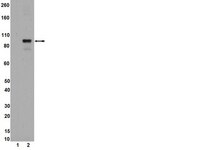H2O2 production downstream of FLT3 is mediated by p22phox in the endoplasmic reticulum and is required for STAT5 signalling.
Woolley, JF; Naughton, R; Stanicka, J; Gough, DR; Bhatt, L; Dickinson, BC; Chang, CJ; Cotter, TG
PloS one
7
e34050
2012
Show Abstract
The internal tandem duplication (ITD) of the juxtamembrane region of the FLT3 receptor has been associated with increased reactive oxygen species (ROS) generation in acute myeloid leukemia (AML). How this elevated level of ROS contributes to the leukemic phenotype, however, remains poorly understood. In this work we show that ROS in the FLT3-ITD expressing AML cell line MV4-11 is reduced by treatment with PKC412, an inhibitor of FLT3, DPI, a flavoprotein inhibitor, and VAS2870, a Nox specific inhibitor, suggesting that ROS production is both FLT3 and NADPH oxidase dependent. The majority of these ROS co-localize to the endoplasmic reticulum (ER), as determined with the H(2)O(2)-specific aryl-boronate dye Peroxyorange 1, which also corresponds to co-localization of p22phox. Moreover, knocking down p22phox dramatically reduces H(2)O(2) after 24 hours in the ER, without affecting mitochondrial ROS. Significantly, the FLT3 inhibitor PKC412 reduces H(2)O(2) in FLT3-ITD expressing cell lines (MV4-11, MOLM-13) through reduction of p22phox over 24 hours. Reduced p22phox is achieved by proteasomal degradation and is prevented upon GSK3-β inhibition. Knockdown of p22phox resulted in reduced STAT5 signalling and reduced Pim-1 levels in the cells after 24 hours. Thus, we have shown that FLT3 driven H(2)O(2) production in AML cells is mediated by p22phox and is critical for STAT5 signalling. | 22807997
 |
Altered interleukin-12 responsiveness in Th1 and Th2 cells is associated with the differential activation of STAT5 and STAT1.
Gollob, J A, et al.
Blood, 91: 1341-54 (1998)
1998
Show Abstract
T-cell activation in response to interleukin-12 (IL-12) is mediated through signaling events that include the tyrosine phosphorylation of STAT4. IL-12 responsiveness and the ability of IL-12 to activate STAT4 is different in T cells induced to differentiate into a Th1 or Th2 phenotype. In this report, we show that STAT5, STAT1alpha, and STAT1beta, in addition to STAT4, are tyrosine phosphorylated in response to IL-12 in phytohemagglutinin (PHA)-activated human T cells. To understand how the activation of these STATs contributes to T-cell IL-12 responsiveness, we analyzed the IL-12-induced activation of STAT5 and STAT1 in T cells stimulated to undergo Th1 or Th2 differentiation. The IL-12-induced tyrosine phosphorylation of STAT5 and STAT1, but not STAT4, is augmented in T cells activated into Th1 cells with PHA + interferon-gamma (IFN-gamma) compared with T cells activated with PHA alone. STAT5 DNA binding induced by IL-12 is also augmented in T cells activated with PHA + IFN-gamma compared with T cells activated with PHA alone, whereas STAT4 DNA binding is not increased. In contrast, the IL-12-induced activation of these STATs is inhibited in T cells activated into Th2 cells with PHA + IL-4. The enhancement of IL-12 signaling by IFN-gamma is not a direct effect of IFN-gamma on T cells, but rather is mediated by IL-12 that is produced by antigen-presenting cells in response to IFN-gamma. This positive autoregulatory effect of IL-12 on the activation of select STATs correlates with an increase in T-cell IFN-gamma production in response to IL-12. These findings suggest that the activation of STAT5 and STAT1 may augment select STAT4-dependent functional responses to IL-12 in Th1 cells. | 9454765
 |










